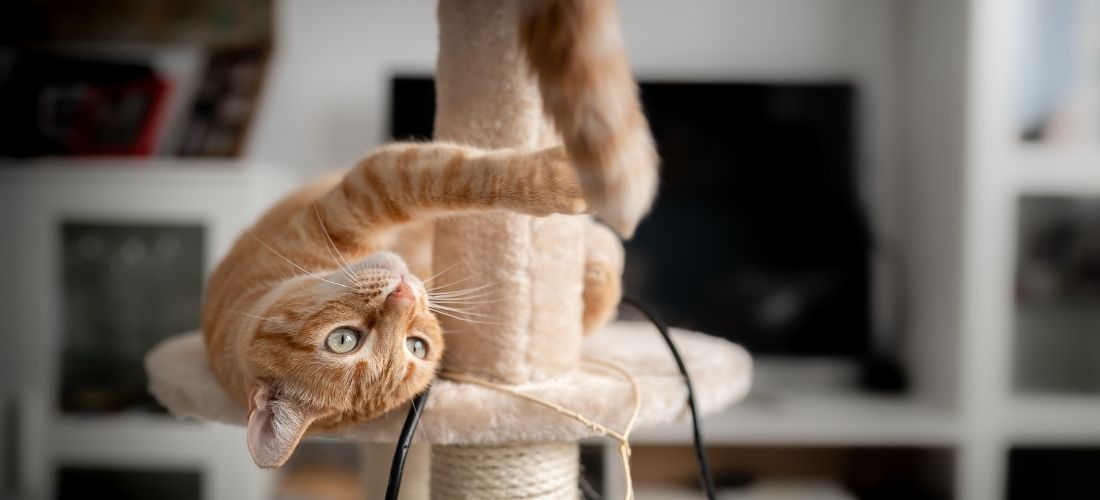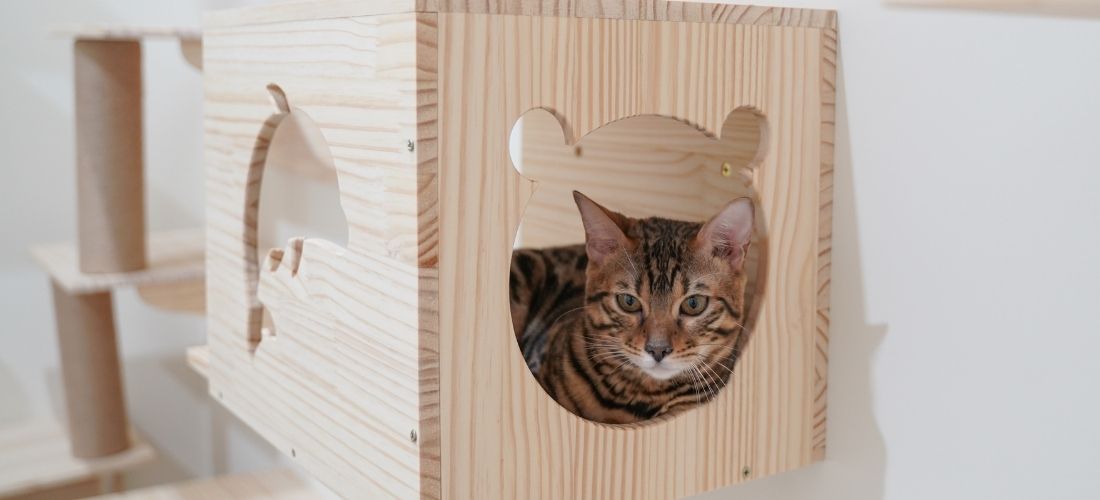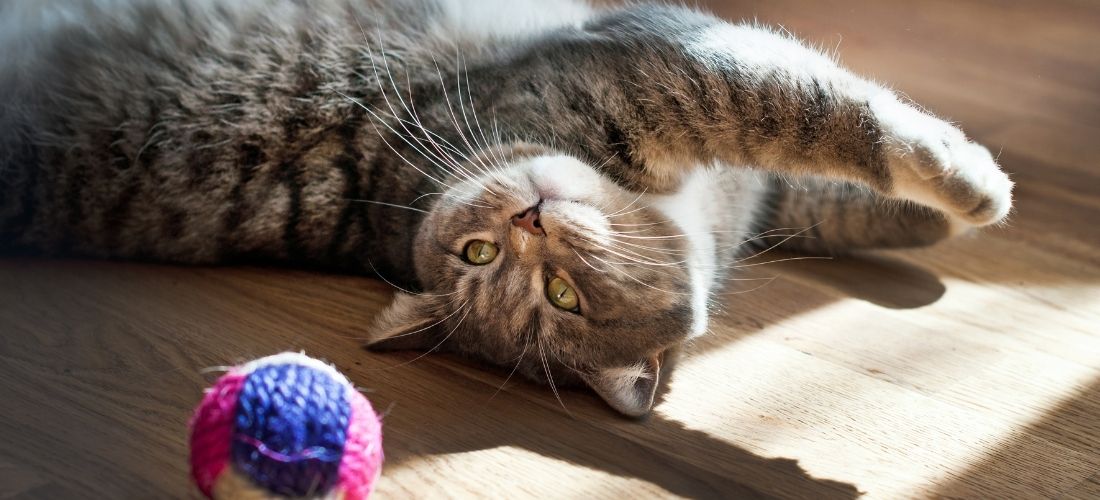Overview
- We all know that cats love to sleep, but daily exercise is also very important to keep them happy and healthy.
- Staying fit and active will reduce your cat’s chance of developing conditions such as diabetes, obesity and arthritis.
- Exercise is also important for your cat’s mental health – it prevents boredom and allows them to express natural behaviours.
- Play is a great way to encourage your cat to exercise – and it's a fantastic way to bond with them.
How much exercise does my cat need?
Cats are naturally active in short bursts, they love nothing more than chasing, pouncing, and ‘zoomies’. If your cat is already slim, active, goes outside to roam, and plays a lot, you may not need to encourage them to exercise. However, if they are a bit more sedate, don’t have access to the outdoors, or are carrying a bit of extra body fat, you might want to consider introducing exercise to their daily routine.
A good place to start is two 15 – 20 minute sessions each day, which you can increase as they get fitter and more enthusiastic. Make sure you keep play sessions short, and always give them enough time to rest in between. Never force your cat to do anything they don’t want to.

How can I exercise my cat?
Play, play, and more play...
In the wild, most of a cat’s exercise comes from hunting, where they chase and pounce – the best way to recreate this behaviour is by playing with them. Here are our top tips for playing with your feline friend:
- Most cats have a preference in toys, so to begin with it’s best to give your cat a variety. Once you’ve established which toys they like best, have one or two out at a time and swap them every few days to keep them interested – playing with the same toy all the time can get a bit dull.
- Although it’s tempting, especially with kittens, it’s not a good idea to use your fingers or toes for play – this will only teach them to grab and bite them, which can be pretty painful!
- Cats are most active at the beginning and end of the day (when they naturally hunt in the wild), so this is a good time to play with them.
- Play in short sessions and give your cat time to rest in-between. Never force them to play if they don’t want to, and stop if they lose enthusiasm.
Exercising indoor cats
It’s especially important to encourage indoor-only cats to get plenty of exercise, as they won’t be burning as much energy in the great outdoors. Just like any other cat, play is a fantastic way to keep your indoor feline friend’s body and mind, happy and healthy – and providing variety is the best way to keep them interested. However, there are a few additional things that you can do within your home to help your indoor cat exercise:
- Controlled access to the outdoors: Indoor-only cats can still enjoy the outdoors if you’re able to provide them with a ‘catio’ (cat patio), or a secure garden. A ‘catio’ is a secure, fenced enclosure, usually attached to the house, and gardens can be secured with specialist fencing/fence toppers, or netting.
- Making your home cat-friendly: Ensuring that your cat has plenty of levels, hiding spaces and toys to interact with around the house is a great way to keep them physically and mentally healthy. Special cat furniture on the walls will encourage your cat to make full use of the house!
- Lots to scratch: Cats love to scratch, regardless of whether they’re inside or outside – however indoor cats will benefit from few extra scratching options around the house. Look for different types of cat scratchers to help make it more interesting for your feline friend – different surfaces such as sisal, wood, cardboard and carpet can all work well!
For more information on indoor cats, take a look at our advice.

Cat toy suggestions
There are plenty of cat toys available to buy, and there are even some you can make at home.
- Balls: Cats enjoy batting at something that moves easily across the floor, such as a ball – just make sure it’s cat safe and that they can’t chew it up or swallow it! Check out our PDSA vet-approved cat safe ball.
- Chase toys: Wind-up, motorised toys, or a long dangly toy dragged across the floor will turn even the laziest cats into a hunter!
- Teaser toys: Teaser toys are ideal toys for cats – they love chasing and jumping for them while they are dragged along the floor and flicked in the air. Just remember to let your cat catch the toy regularly so they don’t get frustrated!
- Fetch: Throwing your cat’s favourite toys will encourage them to run and fetch it. You can use cat-nip toys to do this (or even try making your own!) – simply throw it away from them and reward them if they return it to you!
- Climbing and hiding: Cats love climbing and hiding, and can have hours of fun on a cat tree, a simple cardboard box, or a tunnel – not only does it encourage them to play, it also provides them with some space of their own!
- Puzzle feeders: Puzzle feeders are a great way to combine food with exercise – they challenge your cat to move around and use their brain, with the added benefit of a tasty reward!
- Scratching: Scratching posts are essential if you own a cat, they allow your cat to express their normal scratching behaviour, keep their claws tidy, tone their muscles – and also help save your furniture!
For vet-approved, cat-friendly toys, take a look at our PDSA Pet Store.

Cat toys to avoid
- Wool/string/twine: Never leave your cat unattended playing with string, thread, twine, or wool. If it’s swallowed it can cause a serious gut blockage – something our PDSA vets see very often.
- Laser pens and screen games: We don’t recommend using a laser pointer or screen games on phone/tablet to play with your cat. This is because one of the best parts of playing and hunting is the satisfaction of catching, and laser pointers and digital games have nothing for your cat to physically catch.

